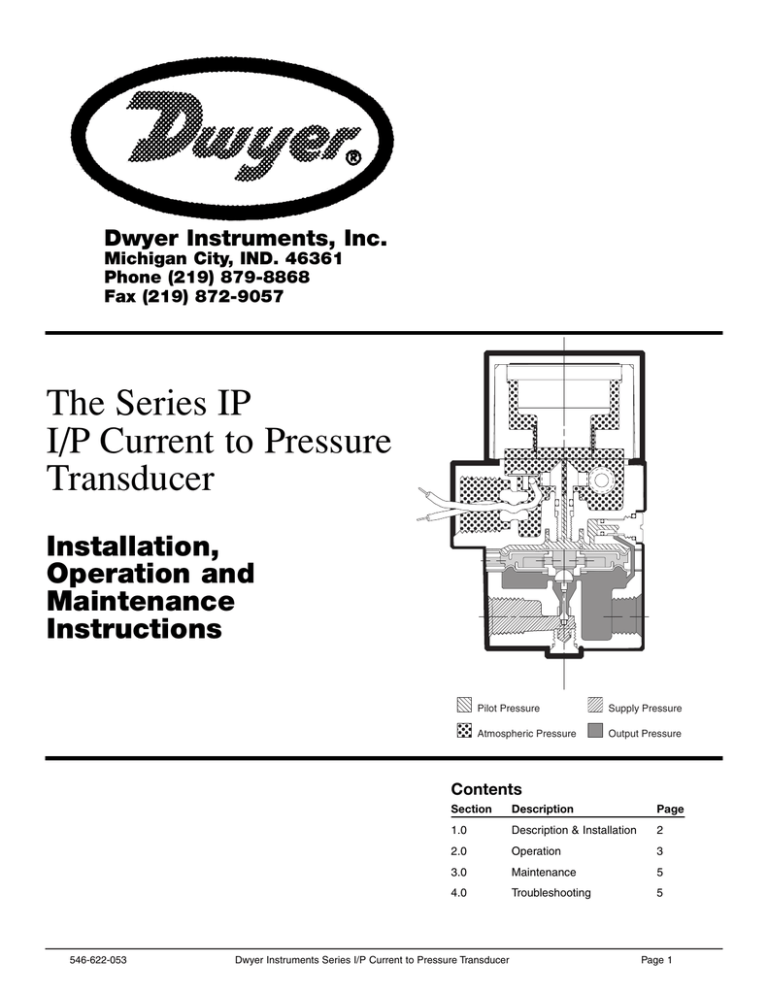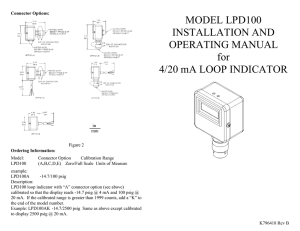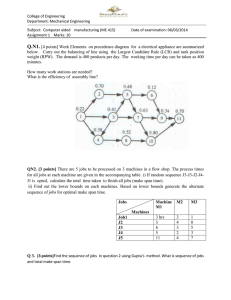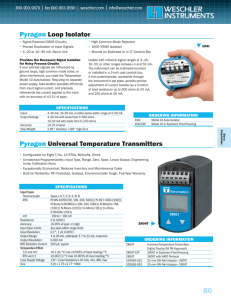The Series IP I/P Current to Pressure Transducer
advertisement

Dwyer Instruments, Inc. Michigan City, IND. 46361 Phone (219) 879-8868 Fax (219) 872-9057 The Series IP I/P Current to Pressure Transducer Installation, Operation and Maintenance Instructions Pilot Pressure Supply Pressure Atmospheric Pressure Output Pressure Contents 546-622-053 Section Description Page 1.0 Description & Installation 2 2.0 Operation 3 3.0 Maintenance 5 4.0 Troubleshooting 5 Dwyer Instruments Series I/P Current to Pressure Transducer Page 1 DANGER, WARNING, CAUTION and NOTE statements DANGER WARNING CAUTION NOTE Refers to conditions or hazards which could result in serious personal injury or death. Refers to conditions or hazards which could result in personal injury. Refers to conditions or hazards which could result in equipment or property damage. Alerts you to facts or special instructions. ALL DANGER, WARNING, AND CAUTION NOTICES MUST BE COMPLIED WITH IN FULL SPECIFICATIONS Min./Max. Supply Pressure Minimum - 3 psig (21 kPa) Above maximum output Maximum - 100 psig (700 kPA) Supply Pressure Sensitivity <± 0.1% of span per psig (<± 0.15% of span per 10 kPa) Linearity <± 0.75% of span Repeatability < 0.5% of span Hysteresis < 1.0% of span Flow Rate 4.5 scfm (7.6 m3/hr ANR) at 25 psig (175 kPa) supply 12.0 scfm (20.0 m3/hr ANR) at 100 psig (700 kPa) supply Maximum Air Consumption .05 scfm (.07 m3/hr) midrange typical Port Sizes 1/4 NPT (Pneumatic) 1/2 NPT (Electric) 1. DESCRIPTION and INSTALLATION 1.1 Description 1.1.1 The Series I/P Current to Pressure Transducer converts a current or voltage input signal to a linearly proportional pneumatic output pressure. This versatile instrument is designed for control applications that require a high degree of reliability and repeatability at an economical cost. 1.2 Principle of Operation 1.2.1 The Series I/P Transducer is a force balance device in which a coil is suspended in the field of a magnet by a flexure. Current flowing through the coil generates axial movement of the coil and flexure. The flexure moves towards the nozzle and creates back pressure which acts as a pilot pressure to an integral booster relay. Input signal increases (or decreases for reverse acting) cause proportional output pressure increases. Zero and Span are calibrated by turning adjust screws on the front face of the unit. Adjustment of the zero screw repositions the nozzle relative to the flexure. The span adjustment is a potentiometer that controls the amount of current through the coil. . 1.3 Mounting 1.3.1 Unit may be pipe, panel, or bracket mounted. Mounting may be at any angle, though may require field adjustment. High external vibration may cause output fluctuations. Mounting in a vibration-free area is recommended. 546-622-053 Dwyer Instruments Series I/P Current to Pressure Transducer Page 2 1.4 Pneumatic Connections 1.4.1 The 1/4 NPT supply and output ports are marked “IN” and “OUT” respectively on the base of the unit. Clean all pipe lines to remove contamination before installation. Apply pipe compound to male threads of the air line only. Avoid getting compound in the air lines. Clean dry instrument quality air must be used. To insure optimum performance supply pressure should be regulated. To provide stable inlet pressure and prevent contamination of the internal section of the transducer the use of an Instrument Air Filter Regulator is recommended. The two unmarked ports on the base of the unit are gage ports but may be used as alternative output ports. Any unused ports must be plugged. 1.5 Electrical Connections 1.5.1 Electrical connections are made to the black and white leads extending out from the 1/2 NPT conduit fitting. When the positive side of the input signal is connected to the black lead, the output pressure will increase as the input signal increases. For reverse acting mode (increasing input signal decreases output pressure), connect positive side of the input signal to the white lead. Figure 1 DIN 43650 Connector 2. OPERATION 2.1 Calibration 2.1.1 Zero and Span should always be checked after mounting. If unit is calibrated in a vertical position and then mounted at an angle, readjustment of the zero is necessary. To calibrate use the following procedure: 1. Open protective covers to expose zero and span adjustment screws. 2. Connect the recommended air supply to the inlet of the transducer and an accurate pressure gage to the outlet. 3. Connect the electrical input and set the input signal to the minimum value of the range being used (e.g. 4 mA for a 4-20 mA unit). 4. Observe the output pressure. If necessary adjust zero screw until reaching minimum output pressure setting. Turn zero screw counter clockwise to increase pressure, clockwise to decrease pressure. NOTE If unable to achieve output during calibration process, turn adjustment screw counter clockwise for up to 30 revolutions, until output pressure rises. 5. Increase electrical input signal to its maximum value (e.g. 20 mA for a 4-20 mA unit). 6. Observe the output pressure. If necessary adjust the span screw until reaching maximum output pressure setting. NOTE For I/P (current) input models turn span screw counter clockwise to increase pressure, clockwise to decrease pressure. For E/P (voltage) input models turn span screw clockwise to increase pressure, counter clockwise to decrease pressure. 7. The Zero and Span adjustments are interactive. After adjusting the span it will be necessary to recheck the zero. Repeat steps 3-6 until both end points are at the required values. 8. For reverse acting performance interchange the black and white electrical signal leads and carry out the same procedure as described above. Note that zero will now be set at maximum output pressure and the span will now be set at minimum output pressure. Figure 2 Electrical Schematic Notes: 1. For 4-20 mA and 10- mA use J1 as positive input. 2. For 10-50 mA change R4 to 100 Ohms. 3. For 1-9 VDC and 0-10 VDC remove R2, use J5 as positive input. 546-622-053 Dwyer Instruments Series I/P Current to Pressure Transducer Page 3 2.2 Dimensional Drawings (Dimensions are in. mm ) (2) #10-32 UNF-2A x .38 DP. Mounting Holes (Shown with Bracket Screws Installed) 1.13 28.7 1.10 27.9 .55 14.0 1.15 29.2 2.88 73.1 2.18 55.4 Max (Square) Removable Mounting Bracket .21 .53 Diameter MNTG. Holes 1.13 28.7 Diameter 4.24 107.7 1/2 NPT 1.12 28.4 1.04 26.4 1.250 31.7 ZERO SIGNAL SPAN 1.50 38.1 IN (2) #18 GA. Wire Leads, 18" Long. Black = Positive White = Negative 1/4 NPT TYP. 1.44 36.6 .55 14.0 OUT Alternate Out/Gauge Port TYP. 180° Apart 1.50 38.1 2.3 Intrinsically Safe Operation 2.3.1 Dwyer Instruments, Inc. offers Factory Mutual Intrinsically Safe approval as a standard feature on all units with a 4-20 mA input signal. Dwyer Instruments, Inc. I/P Models Model No. Signal Output IP-40 4-20 mA 3-9 psig Nom. Imped. 90 Ohms IP-41 4-20 mA 9-15 psig 90 Ohms IP-42 4-20 mA 3-15 psig 180 Ohms IP-43 4-20 mA 3-27 psig 220 Ohms IP-44 4-20 mA 6-30 psig 220 Ohms IP-45 4-20 mA 1-17 psig 250 Ohms IP-46 4-20 mA 2-60 psig 225 Ohms IP-47 4-20 mA 3-120 psig 260 Ohms Notes: 1. Installation to be in accordance with the national electric code, NFPA 70, article 504, and ANSI/ISA RP 12.6. 2. Apparatus connected to the system shall not use or generate voltage greater than 250 VDC. 3. Install intrinsically safe barriers in accordance with barrier instructions. 4. Factory Mutual approved as intrinsically safe for class I, II, and III, Division 1, Groups C, D, E, F and G, when installed with barriers shown. 5. Factory Mutual approved as nonincendive for Class I, Division 2, Groups A, B, C, and D, and suitable for Class II, Division 2, Groups F and G, and Class III, Divisions 1 and 2. Barriers are not required for nonincendive rating. Max. V = 29.9 VDC. 6. CAUTION: Substitution of components may void Factory Mutual approval. 7. Ambient temperature range: -30˚ C to 60˚ C. 8. Factory Mutual approved as intrinsically safe for Class I, II and III, Division 1, Groups C, D, E, F and G when used with an apparatus meeting the following entity requirements: Vmax=29.9 VDC Imax=65 mA Drawing No. 531-990-037 Models 728+, 787S+ and 4045, +24 to +26 VDC, Model 728-, -24 to -26 VDC, available from MTL Inc. 7541 Gary Road, Manassas, VA 221110, USA. 546-622-053 Cl=0 Li= 35 mH Cl is capacitance by the transducer Li is inductance contributed by the transducer 9. For DIN connector option, add D to the model number. 10. For NEMA 4X option, add W to the model number. 11. Models with NEMA 4X are Factory Mutual approved for indoor/outdoor use per the requirements of NEMA 4X as described in the National Electrical Manufacturers Association Standard No. 250 “ Enclosures for Electrical Equipment, 1000 Volts Max.” Dwyer Instruments Series I/P Current to Pressure Transducer Page 4 3. MAINTENANCE Under normal circumstances, no maintenance should be required. If clean dry air is not used the orifice can become blocked. To clean, first turn off supply air, unscrew and remove orifice assembly. The unplug orifice by using a wire that has a smaller diameter than 0.015 in. (0.38 mm). Use compressed air to blow out any loose particles inside the orifice assembly. Replace orifice assembly back into unit. 4. TROUBLESHOOTING PROBLEM CHECK No output or low output Zero adjustment Supply pressure too low Clogged orifice Leakage Connections Low or improper span Zero and Span adjustments Supply pressure too low Output leakage Erratic operation Bonnet Circuit Board Lead Wire O-Ring O-Ring Electrical input signal Loose wires or connections Liquid in air supply Spacer Pintle Spring Bottom Plug 546-622-053 REV 6/19/02 Dwyer Instruments Series I/P Current to Pressure Transducer Body Subassembly Page 5




